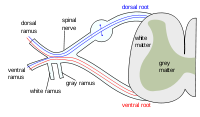
Photo from wikipedia
Hip flexion weakness is relatively common after lateral transpsoas surgery. Persistent weakness may result from injury to the innervation of the psoas major muscles (PMMs); however, anatomical texts have conflicting… Click to show full abstract
Hip flexion weakness is relatively common after lateral transpsoas surgery. Persistent weakness may result from injury to the innervation of the psoas major muscles (PMMs); however, anatomical texts have conflicting descriptions of this innervation, and the branching pattern of the nerves within the psoas major, particularly relative to vertebral anatomy, has not been described. The authors dissected human cadavers to describe the branching pattern of nerves supplying the PMMs. Sixteen embalmed cadavers were dissected, and the fine branching pattern of the innervation to the PMM was studied in 24 specimens. The number of branches and width and length of each branch of nerves to the PMMs were quantified. Nerve branches innervating the PMMs arose from spinal nerve levels L1‐L4, with an average of 6.3 ± 1.1 branches per muscle. The L1 nerve branch was the least consistently present, whereas L2 and L3 branches were the most robust, the most numerous, and always present. The nerve branches to the psoas major commonly crossed the intervertebral (IV) disc obliquely prior to ramification within the muscle; 76%, 80%, and 40% of specimens had a branch to the PMM cross the midportion of the L2‐3, L3‐4, and L4‐5 IV discs, respectively. The PMMs are segmentally innervated from the L2‐L4 ventral rami branches, where these branches course obliquely across the L2‐3, L3‐4, and L4‐5 IV discs. Knowledge of the mapping of nerve branches to the PMMs may reduce injury and the incidence of persistent weak hip flexion during lateral transpsoas surgery. Clin. Anat. 30:479–486, 2017. © 2017 Wiley Periodicals, Inc.
Journal Title: Clinical Anatomy
Year Published: 2017
Link to full text (if available)
Share on Social Media: Sign Up to like & get
recommendations!